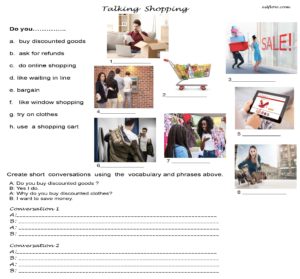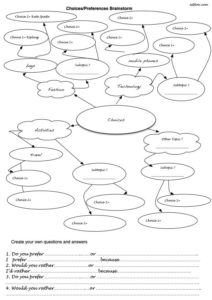Speaking and Vocabulary Activities for Shopping
August 11th, 2023
Shopping is one of those topics that easily engages students if you have good exercises at the right level. Teaching activities might include: shopping role plays, dialogues about shopping experiences, and exercises matching shopping vocabulary words with pictures or definitions.
1 Bargaining
This is a lesson about shopping and bargaining at a market. It includes vocabulary/picture matching, brainstorming, a gap fill dialogue and open-ended questions.
Bargaining gap fill video (YouTube Shorts)
Subscribe to Eslflow
Subscribe on Substack to get the complete lessons with PDFs, audio and video from eslflow.com. There are no ads in the newsletter and you will receive entertaining, high quality, and up-to-date teaching resources regularly. And, if you subscribe, you will be supporting the eslflow website.
2 Gift shop conversation and role play
A gift shop customer – salesperson role play is nice because there are so many kinds of gifts and a variety of interesting and creative conversations can be created by students.
3 Expressing opinions about shopping
A vocabulary and critical thinking exercise for shopping. Students use the words at the bottom of the page to complete the sentences and then agree/disagree with the statements and give reasons for their choices.
3 Talking about shopping
This is an elementary ESL speaking exercise for practicing language useful for talking about shopping. Shopping is a great topic for English language students as it is universally accessible. Using pictures with the questions gives context. The vocabulary at the bottom of the page can be matched to the pictures as an icebreaker. Students can discuss and answer the questions in groups or in pairs.
4 Common expressions for shopping (with audio and answers)
This is an elementary ESL shopping expressions and vocabulary listening/speaking exercise for practicing language useful for talking about shopping. Shopping is a great topic for English language students as it is universally accessible. Using pictures and audio gives context.
Common expressions for shopping (PDF)
(video mp4) (video mp4 on YouTube)
5 Common expressions for shopping 2 (with answers and audio)
This is a slightly more advanced ESL shopping expressions and vocabulary listening/speaking exercise. I often like to make some pictures similar with subtle distinctions so students have to use their critical thinking skills.
Common expressions for shopping 2(PDF)
6 Common shopping conversations (with answers)
This is a fairly elementary exercise. It challenges students to understand the context of each picture and complete the speech bubbles.
Common shopping conversations (PDF)
7 Brainstorming icebreaker for shopping: meanings of colors
A really nice breaker for shopping is brainstorming the meanings and associations of colors. This is a pretty fun and engaging way to start a class.
Brainstorming the meanings of colors(PDF)
8 Fashion and shopping word map
This is an elementary brainstorming exercise that aims to elicit some vocabulary and warm up the students for a lesson about fashion and shopping. Try to get as much vocabulary as possible on the word maps from the students and then ask them to complete the questions at the bottom of the page. Then they can ask and answers questions in pairs or groups.
Fashion and shopping word map(PDF)
9 Talking shopping 2
This is a really easy elementary exercise for pretty low level English language learners to talk about shopping. Students match the words and expressions to the pictures and then have short conversations.
10 Fashion choices and preferences brainstorm and speaking
This is a more advanced exercise for students to talk about shopping choices and preferences. Students match the words and expressions to the pictures and then have short conversations. Once again try to get as much vocabulary as possible on the word maps from the students and then ask them to complete the questions at the bottom of the page. Then they can ask and answers questions in pairs or groups. The students also need to understand how to use “Do you prefer…?” and “Would you rather…?”
Fashion choices and preferences brainstorm (PDF)
Related Resources
Online shopping listening/speaking and vocabulary exercises
3 Clothes, Accessories and Fashion Vocabulary and Speaking Exercises
5 Cool Advertising & Branding Vocabulary & Language Exercises
6 Describing People and Appearance Vocabulary and Language Exercises
7 Brainstorming and Speaking Activities for Routines, Interests and Hobbies
7 Essential Speaking Activities (PDF)






